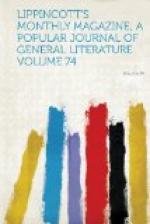The fifth part—Es ist vollbracht (It is fulfilled)—represents Abraham going out to sacrifice his son, prefiguring the Crucifixion. The curtain rises on Sarah, full of agony, which is most simply and powerfully depicted. Attendants enter, who tell a long story: then Abraham and Isaac appear, and there is a most striking scene—Sarah fainting, the friend sustaining her, the others grouped around in various picturesque attitudes. An angel appears, simple and practical, like those of the good old painters, and delivers the blessing. The curtain falls.
Again the orchestra in a superb prelude: then the Chorus appears, and, after the epilogue, divides and kneels as the curtain rises on a tableau which my imagination never could have pictured, for its wonderful completeness, its power, its feeling, its artistic beauty and its marvelous expression far exceeded any idea that I had of the power of men and women to represent such a picture—the Crucifixion.
The stage was crowded with figures, Christ in the centre, fully extended on the cross, with no signs whatever of support to disturb the illusion—the thieves on one side and the other, with arms over the cross, as frequently represented; the group at the foot of the cross so touchingly tender—the soldiers, the priests, the people—all grouped with such consummate skill, such harmony of colors, such appropriateness and vigor of expression, as have never, to my thinking, been excelled in the greatest pictures of the greatest masters. Here was most remarkably shown the wonderful artistic talent and feeling of these simple people. There was nothing repulsive in any way, scarcely painful, except tenderly so. You breathlessly gazed on this wondrous scene, and when, after three minutes, the curtain fell, you were speechless with admiration and emotion. A lovely air by the soprano accompanied this tableau, and after the curtain fell a grand chorus completed the fifth part.
The sixth part—Durch Dunkel zum Lichte (through Darkness to Light)—ended the programme. The play represented Joseph, with all his honors upon him, receiving his old father and his brothers—prefiguring the Ascension of Christ.
After the prelude by the orchestra the curtain rises and discovers old Jacob, surrounded by his sons in various groups. The scene and costumes were admirable and appropriate. In the midst of a discourse Joseph bursts in in fine attire, followed by a great train, among which are two darkies, taken bodily from Flemish pictures. After much embracing and blessing and forgiveness, the curtain falls as Jacob with outstretched arms thanks the Lord and prophesies all good things.
Then again the orchestra, and again our Chorus enters on the scene, and after the epilogue, “At last all woe is ended,” they divide and kneel, as the curtain rises on the scene of the Ascension. This was most simply represented. Christ ascends from the tomb, standing on it, surrounded by angels, while figures appropriately grouped around make a picture which recalled Perugino. The basso sings an aria, and a grand chorus, “Alleluja!” ends this most remarkable performance.




